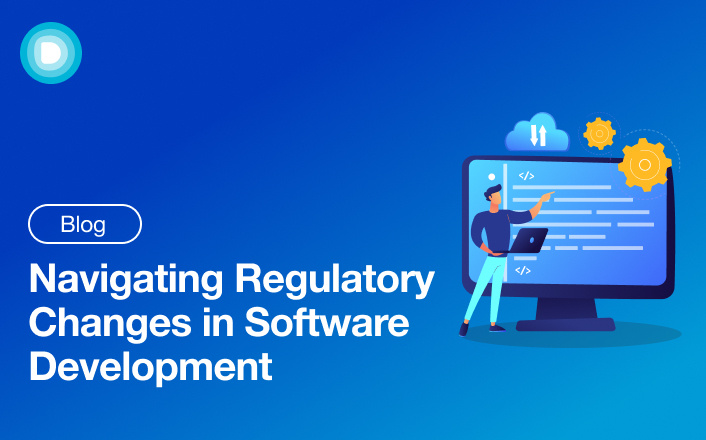- Product
-
Solution
-
By Industry
Cybersecurity solutions tailored to your industry’s needs.
-
- Resources
-
Books
Our ultimate guides and playbooks
Solution Briefs
Overview of PureDome’s functionality
-
Quizzes
Assess your cybersecurity readiness
Case Studies
PureDome customer success stories
Newsletter
Subscribe to the PureDome newsletter
-
- About Us
- Partner
- Pricing
- Download
Staying Ahead of Regulatory Changes: Best Practices for Software Development Agencies
-
Sharmeen Saleem
-
13 May 2024
- 5 min read


Ensuring compliance in app and software development is paramount, as overlooking it can pose significant risks, from reputational damage to legal penalties and financial liabilities. Given the surge in software development trends, cyber theft, malicious attacks, and data breaches have become increasingly prevalent.
During the first quarter of 2023, more than six million data records were breached worldwide. Consequently, software development security and compliance are critical. While security measures ensure protection against data breaches and malicious attacks at every stage of software development, compliance with global IT security standards and regulations strengthens defense mechanisms against potential threats.
This article delves into the complexities of compliance standards within software development, the consequences of non-compliance, and practical strategies for software development agencies to remain proactive amidst regulatory shifts.
What is Regulatory Compliance in Software Development?
Adherence to regulatory standards is a complex undertaking that demands meticulous attention in the multifaceted app and software development landscape. Software development agencies must stay abreast of current laws and regulations, invest in appropriate technologies and resources, and maintain ethical and responsible business conduct. This approach mitigates legal risks and cultivates trust with stakeholders and customers, sustaining app and software development success.
While software developers may not need to be experts in compliance requirements, they should be familiar with fundamental security best practices. Despite the ever-evolving nature of technology, certain core security principles remain constant.
For instance, nearly all compliance regulations mandate:
- Implementing data encryption
- Enforcing appropriate access controls
- Conducting security vulnerability scans

Understanding Common Software Development Regulatory Standards
Today, various well-established software development standards govern and guide software development practices, quality, and processes. Understanding and adhering to these standards benefits software development agencies and individuals because it demonstrates a commitment to best practices, elevates the organization’s standing, and helps mitigate compliance, security, and project delivery risks.

ISO 9001: Quality Management System
Applicable across various industries, not solely limited to software development, ISO 9001 ensures quality management, customer satisfaction, and continuous improvement processes.
ISO/IEC 27001
This widely recognized standard, known for its emphasis on Information Security Management (ISMS), covers critical areas such as access control, risk management, and data protection. ISMS comprises a comprehensive framework of policies, procedures, and processes incorporating physical, technical, and legal controls relevant to an organization's information risk management. Its primary objective is to manage and safeguard sensitive information efficiently.
GDPR (General Data Protection Regulation)
GDPR safeguards data protection and privacy for individuals within the European Economic Area (EEA) and the European Union (EU) and outlines requirements for handling personal data.
HIPAA (Health Insurance Portability and Accountability Act)
HIPAA pertains to the healthcare industry in the United States, setting standards for protecting sensitive patient information.
CMMI (Capability Maturity Model Integration)
CMMI serves as a framework for process improvement in software development and project management. It helps organizations assess and enhance their software development processes to produce higher-quality products.
IEEE (Institute of Electrical and Electronics Engineers)
IEEE encompasses various standards covering different aspects of software engineering, such as documentation, quality assurance, and testing.
ITIL (Information Technology Infrastructure Library)
ITIL provides a set of practices for IT service management (ITSM) and aligns IT services with the business's needs.
FISMA (Federal Information Security Management Act)
FISMA applies to U.S. federal agencies, establishing information security practices to safeguard government information and infrastructure.
OWASP (Open Web Application Security Project)
OWASP produces freely available security-related resources for organizations developing web applications. The OWASP Top Ten identifies and addresses the top security risks in web applications, assisting developers in building more secure software by mitigating common vulnerabilities and threats.
Consequences of Non-compliance in Software Development
Neglecting security and compliance in software development can have dire consequences for your agency and the environment where the software is deployed. Therefore, you must understand the potential repercussions if your agency handles client assets and data using technology.

These risks include:
Cyber Attacks and Data Breaches
Ignoring security measures makes your software vulnerable to hacking and unauthorized access, increasing the risk of data theft. In a cyber attack and data breach, your agency may incur significant losses before damage control efforts begin.
Fines
Non-compliance with laws and regulations can result in hefty fines imposed by federal agencies. For example, HIPAA violations may incur fines exceeding $250,000 per violation. In recent cases, French Data Protection authorities fined Google and Amazon millions for disregarding customer consent regulations regarding non-essential cookies.
Reputational Damage
Exposed data erodes customer trust, leading them to seek alternatives. For FinTech companies, customers may suffer financial losses. Additionally, you may lose trust in your developer, leading to mutual losses and severed ties.
Lawsuits
Customers affected by privacy breaches or data loss may file lawsuits against your agency. These legal battles can incur substantial costs, creating a ripple effect of financial strain.
Loss of License
Failure to adhere to established rules and industry standards in software development could lead to the revocation of licenses, particularly in sectors such as healthcare and finance, exacerbating financial penalties.
Bankruptcy
Customer loss, data recovery costs, reduced productivity, and legal expenses may push your company toward financial insolvency.
Ensuring Security & Compliance in Software Development: 10 Best Practices
The consequences of overlooking security in software development have become evident, demanding urgent attention.
Here are some best practices to ensure compliance and security in software development:

Establish a Secure Foundation
You should prioritize security from the outset, meticulously consider potential threats to the software's integrity, and integrate security measures into every development lifecycle stage.
Defined Response Plan
Develop a structured framework for responding to attacks and mitigating potential damage, discussing the plan before commencing coding.
Employee Training
Provide specialized security training to all development team members, equipping them with up-to-date data security measures and ensuring compliance with industry regulations.
Regulatory Compliance
Adhere to global and regional industry regulations throughout the software development process, including GDPR, ISO 27001 and 22301, NIST, and HIPAA standards.
Secure Software Coding
Implement secure coding practices, such as output encoding, input validation, access control, version control, password management, error handling, and cryptographic techniques to safeguard against cyber attacks.
Meticulously review codes
Conduct regular code reviews to identify and address vulnerabilities promptly before they progress to subsequent stages.
Code Security
Safeguard access to codes in secure digital environments, strictly regulate access to authorized personnel, and monitor for unauthorized changes.
Monitoring
Maintain vigilant monitoring of the software for any suspicious activity, enabling real-time detection of security breaches to minimize data loss.
Security Testing
Perform periodic tests on the software to detect and rectify vulnerabilities. This ensures the software's defensive integrity remains intact and minimizes the risk of data breaches upon deployment.
Consistent Updates
Update the software regularly to enhance user experience and promptly identify and address security vulnerabilities. Stay abreast of evolving trends in data breaches and software vulnerabilities to preempt surprises.
Enhancing Security Measures in Software Development
Adhering to secure coding best practices is crucial when constructing software. These practices ensure your code meets security requirements and remains fast and resilient against malicious attacks. Below are some secure coding best practices that you, as a project manager or organization, should follow in software development:
Identify Vulnerabilities
It is crucial to assess your software for vulnerabilities regularly. A thorough vulnerability assessment involves analyzing your code, architecture, and infrastructure for potential weaknesses. Once identified, you can immediately patch these vulnerabilities and strengthen your software's overall security posture.
Offer Security Awareness Training
Security awareness training is one of the most critical security best practices you can provide your development team. You can deliver comprehensive security training using Learning Management Systems (LMS), Software-as-a-Service (SaaS) platforms, or customized training modules. This will equip your development team with the ability to identify and handle security vulnerabilities during the coding phase.
Leverage Secure Development Tools
Opting for the right development tools significantly impacts the security of your software. Tools such as "Dynamic Application Security Testing" and "Static Application Security Testing" help identify vulnerabilities during development. Integrating these tools into your workflow will ensure you detect the potential threats early on, preventing security gaps from emerging.
Conduct Regular Assessments and Audits to Sustain Security
Security isn’t a one-time measure; it's an ongoing process. Frequent security audits provide insights into the effectiveness of your existing security measures. These audits evaluate your software's resilience to new threats, ensuring that any emerging vulnerabilities are promptly addressed. Consistent audits maintain a proactive security approach, reducing the risk of breaches over time.
Conclusion
Ensuring security and regulatory compliance throughout the software development lifecycle is essential to minimize the risk of malicious cyber-attacks, penalties, damage to reputation, and legal actions post-deployment. Therefore, your software development agency must identify and understand the relevant compliance standards and integrate them into your devOps practices and processes to ensure legal, secure, and ethical conduct.